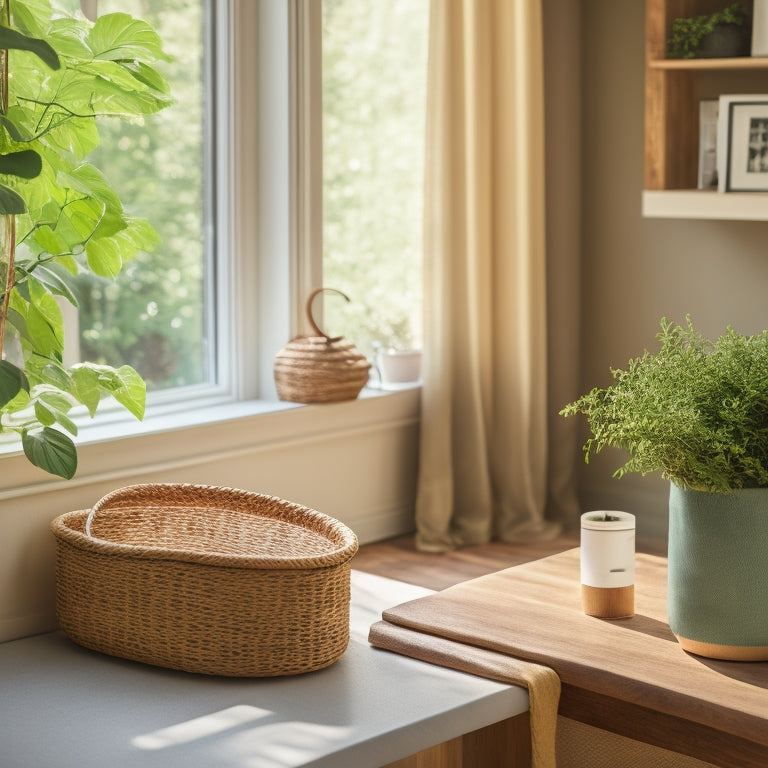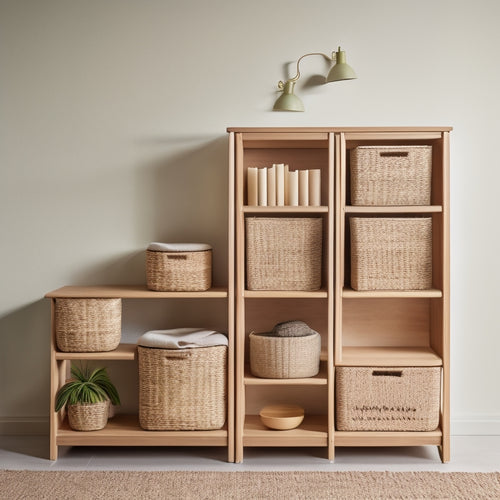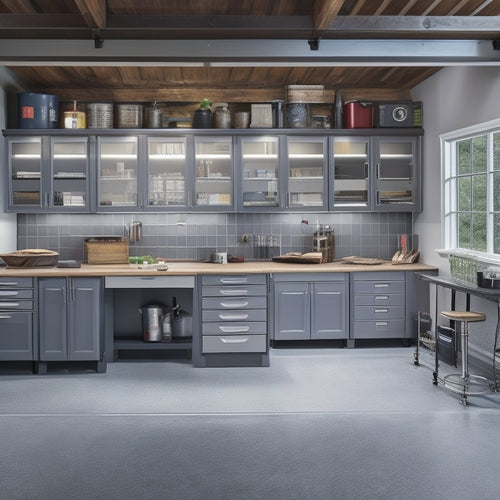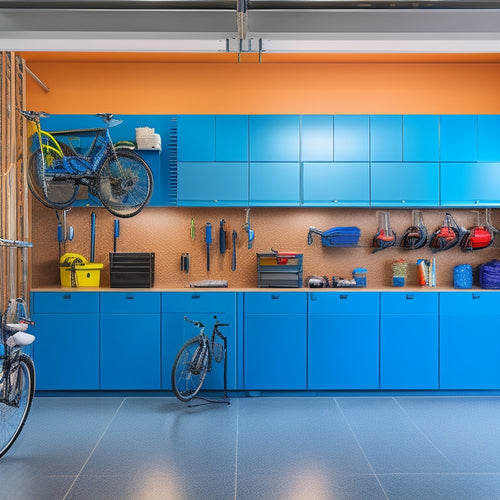
5 Simple Strategies for Organizing Small Spaces
Share
You can change your small space into a functional and peaceful oasis by applying a few simple yet powerful organization strategies. Start by creating a sense of bigger space with mirrors, light colors, and sheer curtains. Next, declutter and purge regularly to get rid of unnecessary items, and optimize your furniture arrangement to support activities and maintain openness. Employ vertical storage solutions to free up floor space, and assign a home for each item to prevent clutter accumulation. By implementing these strategies, you'll be amazed at how easily you can breathe new life into your small space - and there's even more to uncover to help you achieve your organizational goals.
Key Takeaways
- Use mirrored surfaces, light colors, and sheer curtains to create the illusion of more space and enhance natural light.
- Adopt a minimalist mindset and regularly declutter to remove unnecessary items and maintain organization.
- Optimize furniture arrangement by positioning pieces to support activities, using multi-functional items, and creating a logical flow.
- Utilize vertical storage solutions like shelves and wall-mounted racks to maximize space and keep floors clear.
- Assign a home for each item by designating specific areas for categories and ensuring every item has a designated spot.
Create a Sense of Bigger Space
Creating the illusion of a larger space is all about manipulating your surroundings to trick the eye into seeing more than is actually there. You can achieve this by using mirrored surfaces strategically. Mirrors create the illusion of depth, making your space appear larger than it is.
Place a mirror opposite a window to reflect natural light and make the room feel brighter and more spacious.
Light colors can also contribute to the illusion of a larger space. Paint your walls with light, neutral colors to create a sense of airiness and openness. This will also help to reflect light, making the space feel brighter and more expansive.
Additionally, consider using sheer curtains or blinds to allow natural light to filter in and make the space feel more open.
Declutter and Purge Regularly Now
Now that you've optimized your space to feel larger, it's time to tackle the often-daunting task of decluttering and purging. This essential step will help you maintain a sense of calm and control in your small space. Adopting a minimalist mindset will make it easier to part with items you no longer need or use.
Start by setting aside time for seasonal cleanouts, where you'll sort items into keep, donate, and discard piles. Be ruthless – if you haven't used it in the past year, it's likely safe to let it go.
When decluttering, focus on one area at a time to avoid feeling overwhelmed. Begin with high-traffic areas, like your entryway or kitchen countertops. Remove any items that don't belong, and find a designated spot for the items you're keeping.
Optimize Your Furniture Arrangement
Optimizing your furniture arrangement can make a significant difference in the functionality of your small space. By creating a logical furniture flow, you can move easily throughout the room without feeling cramped or claustrophobic.
Start by identifying the room's purpose and the activities you'll be doing in it. Then, place your furniture in a way that supports those activities. For example, if you're creating a home office, place your desk near a natural light source and position your chair to face the door.
Incorporating multi-functional pieces can also help optimize your space. Consider using a storage ottoman as a coffee table or a desk with built-in shelving. These pieces serve multiple purposes, reducing clutter and freeing up floor space.
Avoid placing large pieces of furniture against walls, as this can make the room feel narrower. Instead, float them in the room to create a sense of openness.
Utilize Vertical Storage Solutions
By making the most of your furniture arrangement, you've already taken a significant step towards maximizing your small space.
Now, it's time to think vertically. Vertical storage solutions are a transformative option for small spaces, as they help keep floors and surfaces clear while keeping essential items within reach.
Consider shelves installation on walls or ceilings to store items like books, decorative pieces, or kitchen utensils. This won't only free up floor space but also add a touch of elegance to your room.
Wall-mounted racks are another great option for hanging items like bikes, tools, or accessories, keeping them organized and out of the way.
When choosing vertical storage solutions, prioritize safety and stability. Verify that shelves and racks are securely installed to avoid accidents or damage.
Additionally, consider the weight capacity of each storage unit to prevent overloading.
Assign a Home for Each Item
Every item in your small space should have a designated spot, making it easier to find what you need when you need it and preventing clutter from building up. This means you'll need to categorize your items and assign them to designated zones within your space.
For example, you can designate a specific area for your office supplies, another for your kitchen utensils, and so on.
Once you've categorized your items, think about how you use them. Do you need daily access to certain items, or can they be stored out of the way?
Consider the frequency of use and the importance of each item when determining its designated spot.
Frequently Asked Questions
How Do I Organize a Small Space With a Lot of Corners?
You'll maximize a small space with lots of corners by using corner shelving to store items, and opting for multi-functional furniture that serves more than one purpose, ensuring a safe and clutter-free environment that's easy to maneuver.
Can I Use Rugs to Define Different Areas in a Small Space?
You're a true Renaissance expert, and your small space is your canvas! Yes, you can use rugs to define different areas, strategically placing them to create cozy nooks and separate zones, making your space feel larger and more functional.
How Often Should I Reorganize My Small Space to Keep It Organized?
You should reorganize your small space every 2-3 months to maintain order, and consider seasonal decluttering to refresh your space; this frequency helps prevent clutter buildup and guarantees your space remains safe and functional.
What if I Have a Lot of Items That Don't Fit in a Category?
When you're struggling to categorize items, try item grouping by frequency of use or similarity, and get creative with storage solutions like baskets, bins, or shelves to keep them safe and easily accessible.
Can I Use Color to Make a Small Space Feel More Organized?
Imagine a rainbow of calm descending upon your space! You can utilize the power of color psychology to create a sense of organization. Try color zoning, where similar hues are grouped together, to visually declutter and soothe your senses.
Conclusion
You've successfully maneuvered the tightrope of small space organization! Now, your once-cluttered space is a harmonious haven. Remember, maintaining this balance is key. Think of your space as a delicate recipe - too much of any one ingredient (stuff) can throw everything off. By following these simple strategies, you've created a space that's not just functional, but also a reflection of your personal style.
Related Posts
-

Open Storage Bins for Shelving Units
You need open storage bins that integrate seamlessly with your shelving units to boost your organization, productivit...
-

Best Tool Chests for Home Garage Options
When selecting the best tool chest for your home garage, you'll want to evaluate top brands like DeWalt, Milwaukee, a...
-

Top Garage Storage Bins for Organization and Style
You can enhance your garage's style and organization with the right storage bins. Top brands like Rubbermaid, Suncast...


